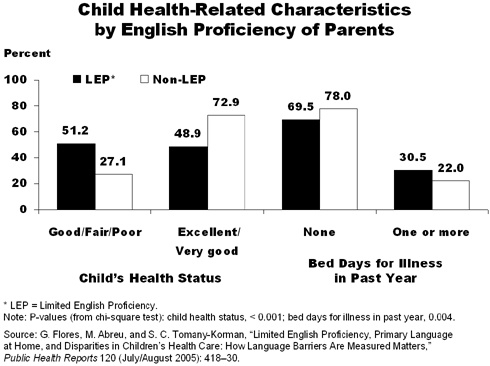Over the past two decades, the number of Americans who speak a language other than English at home has increased, as has the number of Americans with limited English proficiency (LEP). Previous research has shown that disparities in children's health and health care are associated with both of these factors. New research shows, however, that LEP is the more useful measure in gauging the impact of language barriers on children's health and health care.
In the Commonwealth Fund–supported study, "Limited English Proficiency, Primary Language at Home, and Disparities in Children's Health Care: How Language Barriers Are Measured Matters" (Public Health Reports, July/August 2005), researchers found that LEP parents are three times more likely than parents who report speaking English "very well" to have a child in fair or poor health. The authors did not, however, report similar findings for homes in which a language other then English is spoken, concluding that parental LEP is "superior to the primary language spoken at home as a measure of the impact of language barriers on children's health and health care."
Methods
To conduct the study, the researchers surveyed parents of children ages 18 and under in six communities in the metropolitan Boston area. Parents were approached at community sites, including supermarkets, laundromats, and beauty salons, between February and December 2002. In all, 1,100 families were surveyed on parental LEP, primary language spoken at home, children's health status, access barriers, and use of services. English proficiency was determined by asking parents how well they speak English: very well, well, not very well, or not at all.
LEP, Insurance, and Health Status
The researchers found that children of parents proficient in English are less likely to be uninsured (6% of the "very well" category) and more likely to have private insurance (26% of the "very well" category), compared with LEP parents (27% and 10%, respectively, of the "not at all" category). They also found a relationship between severity of LEP and children's health status: parents who speak English well are less likely to have a child in fair or poor health than those who do not speak English at all.
After adjusting for other variables, LEP parents are three times more likely than English-proficient parents to have a child in fair or poor health and twice as likely to have had a child spend one or more days in bed with an illness in the past year.
The lowest-proficiency parents may be less aware that their children's health status and care are not optimal, the researchers say, or may feel less entitled to care due to recent immigration status or prior discrimination.
Use of Services
Children of LEP parents were less likely to receive needed medical care due to barriers like cost, transportation, difficulty making appointments, insurance status, and physicians' office staff not understanding the family's culture.
In contrast, only one significant relationship was found between primary language spoken at home and access barriers: when faced with inconvenient clinic hours, parents were less likely to bring children in for needed care in both non-English households and in households where English and another language were spoken. For any of the seven other access barriers for which odds ratios could be calculated, primary language spoken at home was not significantly associated with children not being brought in for care.
Policy Implications
The researchers conclude that parental LEP is a more precise measure of language barriers in health care than is language spoken at home. Health care organizations, managed care plans, and government agencies should take note of these findings, the authors say. Collecting LEP data will not only help track disparities in quality of care, processes, and outcomes, but doing so can help provide essential information on families' needs for interpreter services. Furthermore, the authors suggest that pediatric providers can help families improve the overall care and well-being of their children by referring parents to low-cost and free English as a Second Language classes.
Facts and Figures
- Forty-seven million Americans, or 18 percent of the U.S. population, speak a language other than English at home. Twenty-one million Americans, or 8 percent of the population, have limited English proficiency.
- Among study parents who said they speak English "not at all," 27 percent of their children were uninsured. Among parents who speak English "very well," only 6 percent of their children were uninsured.
- For six of nine access barriers studied, parents with limited English proficiency were less likely than English-proficient parents to bring their children to a doctor for needed care.



